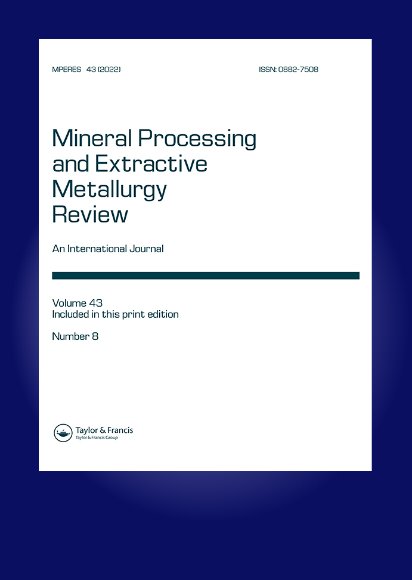糊精作为生态友好抑制剂在白钨矿和方解石矿物选择性浮选分离中的应用研究
IF 4.6
3区 工程技术
Q1 METALLURGY & METALLURGICAL ENGINEERING
Mineral Processing and Extractive Metallurgy Review
Pub Date : 2023-10-22
DOI:10.1080/08827508.2023.2270132
引用次数: 0
摘要
摘要抑制剂是白钨矿—方解石浮选分离中不可缺少的助剂。然而,水玻璃等传统无机抑制剂由于用量大、污染环境、效率低等缺点,人们越来越关注环保、高效的有机替代品。在本研究中,多糖糊精作为绿色抑制剂用于白钨矿和方解石的浮选分离。微浮选实验表明,在自然pH下,糊精选择性抑制方解石,而白钨在油酸钠(NaOL)的捕收剂作用下仍可浮选。吸附密度和zeta电位结果表明,糊精优先吸附在方解石表面,阻止了随后的NaOL吸附。相比之下,糊精与白钨矿的相互作用较弱,使得NaOL被吸附在白钨矿表面。傅里叶红外光谱(FTIR)分析和密度泛函理论(DFT)计算表明,方解石表面的Ca2+活性位点与糊精碳环上的-OH基团相互作用。x射线光电子能谱(XPS)测试证实了糊精-OH基团与矿物表面Ca2+活性位点之间的化学相互作用,而且方解石的相互作用要比白钨矿强得多。论文作者姚伟、吴玥:概念、方法、数据整理、形式分析、调查、撰写-原稿。李茂林,崔睿,张明:概念化,项目管理。李佳颖,杨哲辉,傅莹莹,潘志勤:形式分析。王道伟:形式分析、写作、评审、编辑。感谢国家自然科学基金(项目编号:51704214和51704215)和武汉科技大学“十四五”湖北省优势特色学科(群)项目(编号:2023A0401)的支持。作者还要感谢Shiyanjia实验室(www.shiyanjia.com)进行的XRD和XPS测试,并感谢阿尔伯塔大学的Qi Liu教授提供了用于浮选的改良哈利蒙德管。本研究得到国家自然科学基金资助[51704214];武汉科技大学“十四五”湖北省优势特色学科(群)项目[2023A0401]。本文章由计算机程序翻译,如有差异,请以英文原文为准。
Exploring Dextrin as an Eco-Friendly Depressant for Selective Flotation Separation of Scheelite and Calcite Minerals
ABSTRACTDepressants are essential additives in the flotation separation of scheelite-calcite minerals. However, traditional inorganic depressants such as sodium silicate have the disadvantages of high dosage, environmental pollution, and being non-efficient, which leads to a growing interest in eco-friendly and effective organic alternatives. In this study, a polysaccharide, dextrin, was used as a green depressant for the flotation separation of scheelite from calcite. Micro-flotation experiments indicated that dextrin selectively depressed calcite at natural pH yet scheelite remained floatable using sodium oleate (NaOL) as a collector. Adsorption density and zeta potential results indicated that dextrin was preferentially adsorbed on the calcite surface and prevented the subsequent NaOL from adsorption. By contrast, dextrin had a weak interaction with scheelite, allowing NaOL to be adsorbed on the scheelite surface. Fourier transform infrared spectroscopy (FTIR) analysis and density functional theory (DFT) calculations suggested that the Ca2+ active sites on the calcite surface interacted with -OH groups on the carbon ring of dextrin. X-ray photoelectron spectroscopy (XPS) tests confirmed the chemical interaction between -OH groups in dextrin and Ca2+ active sites on the mineral surfaces, and importantly, the interaction was much stronger for calcite than for scheelite.KEYWORDS: Dextrindepressantgreen chemicalflotation separationscheelitecalcite Credit authorship contribution statementWei Yao and Yue Wu: Conceptualization, Methodology, Data curation, Formal analysis, Investigation, Writing – original draft. Maolin Li, Rui Cui, and Ming Zhang: Conceptualization, Project administration. Jiaying Li, Zhehui Yang, Yingying Fu, and Zhiqin Pan: Formal analysis. Daowei Wang: Formal analysis, Writing – review & editing.AcknowledgmentsThe authors would like to thank the National Natural Science Foundation of China (Project No. 51704214 & 51704215) and “the 14th Five Year Plan” Hubei Provincial advantaged characteristic disciplines (groups) project of Wuhan University of Science and Technology (2023A0401) for support. The authors would also thank the Shiyanjia Lab (www.shiyanjia.com) for the XRD and XPS tests and thank Prof. Qi Liu at the University of Alberta for offering the modified Hallimond tube for flotation.Additional informationFundingThe work was supported by the National Natural Science Foundation of China [51704214]; “the 14th Five Year Plan” Hubei Provincial advantaged characteristic disciplines (groups) project of Wuhan University of Science and Technology [2023A0401].
求助全文
通过发布文献求助,成功后即可免费获取论文全文。
去求助
来源期刊

Mineral Processing and Extractive Metallurgy Review
工程技术-矿业与矿物加工
CiteScore
10.30
自引率
18.00%
发文量
55
审稿时长
2.8 months
期刊介绍:
Mineral Processing and Extractive Metallurgy Review publishes both theoretical and practical papers relevant to technical, economic, and environmental issues in the handling, processing, and utilization of minerals. In addition to regular issues, special issues focusing on subjects of regional and topical significance will be published when the Editor feels there is sufficient interest among readers.
 求助内容:
求助内容: 应助结果提醒方式:
应助结果提醒方式:


